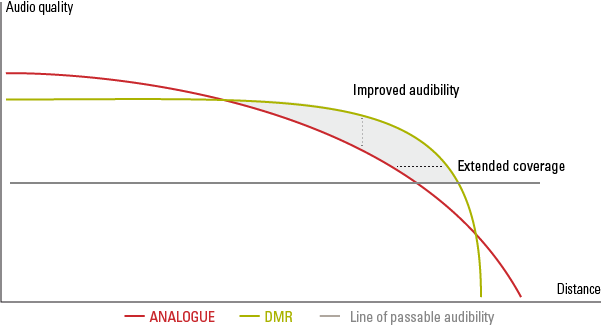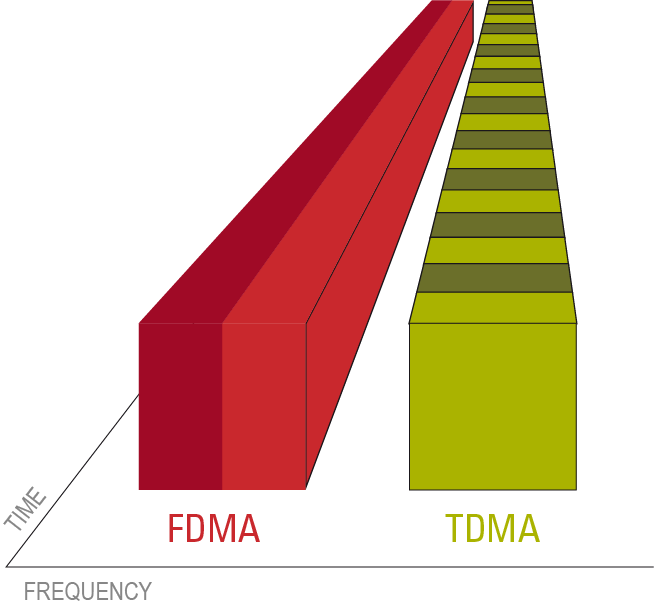An introduction to MOTOTRBO™
Best-in-class noise cancelling
After being digitized the recorded data is filtered and compressed by focusing on human speech. This results in that ambient sounds are not noticeable on the receiver side.
Since Digital Mobile Radio (DMR) converts speech to a digital bit stream it manages both voice and data identically, a.k.a. they are integrated. As a result the equipment also provides transfers of data like text messaging.
Consistent audio
Digital radio communications also provides a more consistent quality of sound throughout the coverage area. This due to that the data is sent as small packages which means they will either arrive intact or not at all. The diagram illustrates this principle. The area above the line of passable audibility equals the improvement in audibility while the area right of the intersection between the analogue signal and the line of passable audio shows the extended reach.

Analogue and/or digital support allow for backwards compatibility
The simultaneous support for analogue and digital programming allows the equipment to be used in all digital DMR systems as well as conventional systems. Since the terminals can be programmed with both analogue and digital channels at the same time they can even be used in the different set-ups by simply turning the knob. This also lets you migrate your equipment in your own pace or rather, MIGRATE TO DIGITAL.
The repeaters in the MOTOTRBO™ family also support a so-called Dynamic Mixed Mode which means it senses if a radio is broadcasting digitally or in analogue and adjusts accordingly. Thanks to this you can let different departments or teams migrate separately from the rest of the organisation.
Twice the capacity
The other integral technology responsible for DMR’s benefits is TDMA, or Time Division Multiple Access. This is a method for dividing a discreet radio channel in time, to create what is known as timeslots which in practice act as two separate channels. The method enables two independent calls on the same discreet channel simultaneously, thereby doubling the capacity of the available channel. This is compared to FDMA, where you instead cut the channel spacing in half.
A two-way radio uses most energy when transmitting and since TDMA decreases transmission time it also results in an increase in battery life (a 30-40% increase according to tests performed).

Increased functionality thanks to a wide range of applications
Thanks to digitalisation, integrated voice and data and support for standardised interfaces (USB, etc) MOTOTRBO™ is easily integrated with other technologies. Since DMR is an international standard all information about its protocol is available to anyone.
This has led to that a lot of third party developers have developed applications and solutions that fit, utilize or improve on MOTOTRBO™. This continuous evolution has produced a considerable amount of value adding applications within;
Resource management
Remote control
Computer aided dispatch
Integration with services like Google Maps
Integration with other radio systems
Indoor positioning
Telemetry
Call logging/Voice recording
Telephone interconnect
Crossband signalling
Motorola have also developed their own add-ons to their infrastructure to further increase capacity and capability of the systems.
IP Site Connect
The option IP Site Connect lets you connect base stations via IP to extend the coverage area. The option can also be used to create a unified system that covers different places, by connecting the base stations at the dispersed locations, no matter the distance.
Capacity Plus
The Capacity Plus option adds trunking to a MOTOTRBO™ system. Trunking is a method of letting individuals efficiently share a resource. I the world of radio communications this means that all users (radios) are normally placed in a rest channel (cue). When a call is placed it is automatically assigned a vacant channel. When ended the radios revert back to the rest channel and the used channel becomes vacant again. This way the system capacity can be substantially increased compared conventional systems/cues.